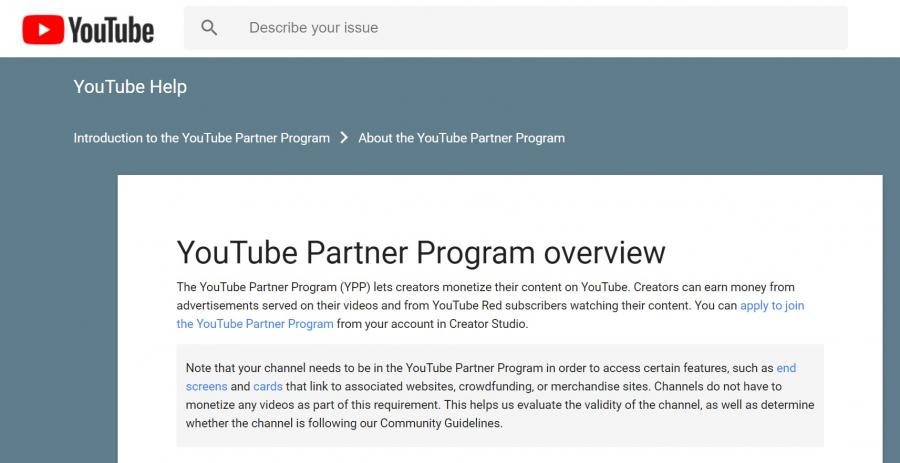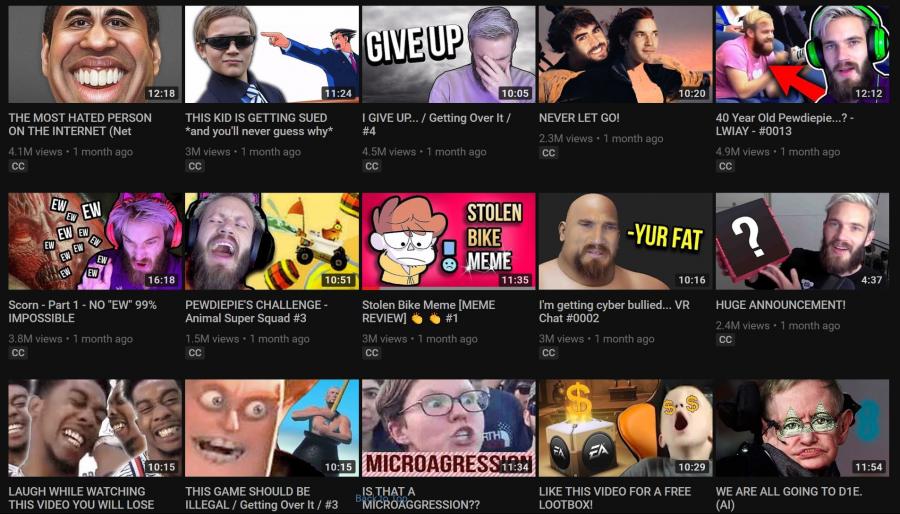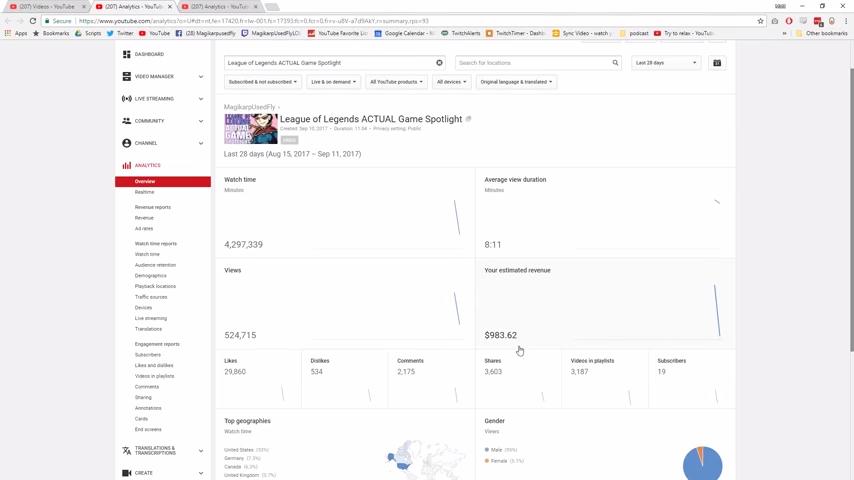
YouTube's demonetization situation and the adpocalypse
YouTube, the most famous and global video sharing platform, is home to an overwhelming amount of content creators, spanning across a multitude of different genres. However, the monetization scheme and the adpocalypse that followed have changed things for the worse.
YouTube channels come in many different shapes and sizes and for different purposes. Some people use the platform solely to privately share videos with family and friends, whilst others use it to produce content for the rest of the world to see. In fact, it has even gotten to the point where many people have resorted to their YouTube channels as their full-time job and therefore their primary source of income. Even though this was a pretty solid plan of action for a while, YouTube has changed a couple of its rules and their approach to this monetization scheme as well. As a result, many YouTubers now make significantly less money than they did before and are publicly criticizing YouTube for their approach. One content creator, Matthew "MagikarpUsedFly" Castro, voiced his opinion in a somewhat satirical manner in the video below.
Language warning: The following video contains strong language use.
Advertising in the Context of Web 2.0
To be able to sustain a platform as massive as YouTube, lots of money for maintenance has to be in place somewhere within the organisational strcture of said platform. This money is almost always earned through the use of advertisements, and in the case of the internet: targeted advertisements. Because the concept of Web 2.0 involves having a highly interactive and therefore dynamic internet, the user will be bombarded with advertisements when they enter a site such as YouTube. These advertisements come in vaious forms, such as banner advertisements during a video and regular advertisements that play before the content the user actually came to watch.
As discussed by Joëlle Farchy in "The Youtube Reader", YouTube provides its advertisers with all kinds of possibilities to promote their content. The more demands an advertiser may have, the more YouTube can charge them for their provided advertising services. Since YouTube could easily be considered to be a global platform, the reach that these advertisers will have by using YouTube to place their ads is quite literally worldwide. In the U.S. alone, advertising expenditures on the internet reached roughly 30 billion dollars back in 2007, an amount which was expected to be doubled in 2010. In the European market, the 7.7 billion euros spent for online advertising in 2007 was expected to grow to 13.9 billion by 2012 (The Youtube Reader, n.d.).
The Youtube Partnership Program
Content creators are eligible for a partnership with YouTube when they meet certain requirements, like having 10,000 total video views, as of April 2017 (Investopedia 2017), which in turn allows them to monetize their videos. Generally speaking, monetization makes it possible for you to make money with your videos, by letting YouTube use them for advertisement purposes. These advertisements are the largest factor in how much money you will make. By allowing YouTube to do this, third parties will generate revenue and a portion of said revenue goes to you as the content creator. This revenue is generated on a per-click basis, so every time an advertisement pops up on a video, those 5 unskippable seconds will produce a certain amount of money for the YouTuber, as well as the advertiser. Through this system, many YouTubers make a modest living and are able to sustain themselves.
This, along with various other platforms other than YouTube, plays a large part in Google's business model. When they acquired YouTube back in 2006, they also acquired AdWords and DoubleClick, two advertising services. YouTube then started to experiment with advertisements on videos. This eventually became the Youtube Partner Program (YPP) and allowed YouTubers to generate income through their videos. Since YouTube was now a part of Google, all of the data gathered using Google Search results could now be used for targeted advertising, as a byproduct of Web 2.0. This is because you are now within Google's ecosystem. The videos you watch on YouTube will affect the advertisements you see in the search engine and vice versa.

Google's information page for the YPP
Exposure through Algorithms
Another result of the YPP is that videos created by partnered content creators would often gain priority in YouTube's algorithms (Van Dijck 2013). Their videos would, for example, get priority for being shown on the YouTube homepage, your personal feed, customized through subscription services, or even your recommended videos list. This can be seen as a form of subtle encouragement to watch certain types of videos that may interest you and will therefore cause you to broaden your horizon. From a more economic perspective, it is also a highly clever, yet simple, plan for increasing the amount of revenue YouTube, advertisers and content creators make. What will happen is that while your YouTube experience is being dominated by YouTube picking your videos for you, the chance that you will discover an 'up-and-coming YouTuber' or 'someone with talent' are significantly lower. It seems that YouTube now values advertising profits over creativity.
Additionally, the fact that advertisements generate income on a pay-per-click basis indirectly encourages foul play from content creators. By using titles and/or thumbnails of mysterious or suggestive nature, people are more likely to click on their videos due to being intrigued. However, these elements are usually unrelated to the content of the video itself and are solely used to lure you in. This phenomenon is known as 'clickbait' and is not a problem exclusive to YouTube. It is also a common trend on certain news sites to increase the traffic they get. However, on YouTube it can be considered more profitable. Once a video has been clicked on and the advertisement starts playing, the money has already been made. Even if you were to leave after 10 seconds because you realize that you've been tricked, they have already profited from your click.

Felix "PewDiePie" Kjellberg's YouTube feed contains genuine content as well as clickbait
Difference in Quality and the Participation Dilemma
Even though YouTube's YPP strongly encourages content creation and sharing, it also looks like easy money for a significant amount of people. Plenty of these "anybodies" who haphazardly publish unpolished content for a quick buck show they do not actually hold any skills in the art of video making. The quality of their videos therefore suffers, yet they still profit from their videos due to YouTube's monetization scheme. In the highly unllikely case one of their videos goes viral, it is immeasurably more successful than someone's video that has been produced with a lot of skill and technical expertise.
This concept is also described as the "participation dilemma". According to Eggo Müller (2009), the dilemma is that whilst non-professionals are now able to enter the field and contribute to it, the surge of newcomers also means that they will tend to ignore professional standards and techniques that have already been developed. In those instances where these inexperienced newcomers are trained to incorporate professional standards, this will simply recreate the participatory cultures that existed prior to the entry of said newcomers.
What was the Problem?
In the summer of 2017, YouTube started to demonetize a lot of videos because of some controversy that took place on the video-sharing platform. For one, it was found that certain groups such as Hezbollah were uploading videos and monetizing them. Not only were Hezbollah promoting their immoral actions, they were profiting from their videos as well. On a more local scale, Felix "PewDiePie" Kjellberg uploaded a video in January 2017 for which he paid some people to hold signs saying "Death to all Jews". Given the name and status that PewDiePie holds in the YouTube community as the most subscribed to (59 million as of January 2018) and therefore most famous content creator, this created a lot of controversy. This incident also caused Disney, with whom PewDiePie was working at the time, to cut ties with him. He has since claimed that the video was supposed to be satirical and has taken it down.
Because of these two events, many third parties withdrew their partnership with YouTube, causing a large drop in revenue for both YouTube and its content creators, often referred to as the 'adpocalypse'. As advertisers slowly made their way back to the platform, YouTube started employing artificial intelligence to decide whether content is 'adpropriate' or not. This meant that videos would be checked against the YouTube guidelines as they were uploaded and were only then considered for monetization. Whilst this may sound like an effective system, in reality it is far from it.
The Problems with YouTube's Solution
The system is continuously demonetizing videos for seemingly no particular reason and that is affecting many YouTubers' ad revenue. Whilst it is possible for creators to appeal to YouTube to manually check their videos and make them eligible for monetization again, the lion's share of the views a video gets is always within the first three days of upload and those views will go unrewarded. On top of that, because of the sheer number of videos uploaded, it could take a while for YouTube to act on the false demonetization. As a result, YouTube has offered a solution to its partners: "If you want to check the monetization status before making the video public, you can upload it as unlisted. If you think we got it wrong and your channel has more than 10,000 subscribers, you can appeal, and we will review your unlisted video regardless of view count." (Forbes 2017). However, as seen in MagikarpUsedFly's video above, that system is still flawed and a video preapproved for monetization might still be demonetized after a short period of time.
At the beginning of MagikarpUsedFly's video above, he tried his luck with the monetization system by uploading his video as unlisted, to get it checked by the system. After it was deemed 'not advertiser friendly', he removed all of the inappropriate content and proceeded to re-upload his video as normal, only for it to remain demonetized, causing a drop in his revenue. Whilst this does not affect him that much, he says, it does pose a very large problem for smaller YouTubers, which is featured throughout the video, because their viewership is incredibly small compared to other YouTube giants.

MagikarpUsedFly openly sharing his ad revenue figures
Given that advertisers pay the creators on a pay-per-click basis, they make little money as it is. After the adpocalypse and YouTube's implementation of artifical intelligence to monitor the initial monetization status of videos, they make even less money. This serves as a very high barrier of entry for anyone who would like to enter this 'business', making it very difficult, if not almost impossible, for them to succeed on the platform. YouTube, in a global sense, could then be considered an oligopolistic market because of this. As a result of the demonetization significantly cutting the income of smaller-size YouTubers, many creators resort to a Patreon account, on which fans can directly contribute money to their favorite YouTubers in exchange for exclusive content. Naturally, the fame of Patreon has significantly increased since the adpocalypse, and could pose a potential threat to YouTube if YouTube maintains their current course.
"The problem is they have an unholy amount of video uploaded to their service every minute. They don't have enough people to monitor all of it, and they have no interest in monitoring all of it." - John "TotalBiscuit" Bain
Increased Levels of Communication
TotalBiscuit, as well as other YouTubers, state that the primary issue they have with YouTube as a governing body is that the platform does not communicate with its creators. YouTube are making all of these decisions by themselves and are forcing them onto their users without their consideration. Given the size of YouTube as a media platform, they should be very clear on what the creators should be doing to succeed if they want to maintain their highly successful business model.
According to TotalBiscuit, the communication used to be a lot better and more effective when the platform was still considerably smaller. Advertisers would come to Google and ask for content to be produced with regards to their products, and Google would suggest a group of YouTubers that the product could work well with. That way, they also immediately reach the right target audience.
More Respect for Creators
Not only is the communication from YouTube bad, they are now also being scrutinized for the disrespectful way they treat their creators. For example, at the end of each year, YouTube creates a video titled 'YouTube Rewind' in which they review the year's hottest trends and memes. This also includes a lot of live appearances from famous YouTubers. However, because YouTube is an ever-growing platform, that number of 'famous YouTubers' keeps rising every year and YouTube is having a very difficult time managing the creation of the rewinds. They used to properly star all the YouTube celebrities and give them a spotlight like in the 2013 Rewind. With their 2017 rewind, it seems that these same YouTubers only get a maximum of two seconds screentime, and therefore I find myself pausing the video every couple of seconds to see if I recognize anyone. Emma Blackery, a British YouTuber has expressed her disappointment at YouTube for the way they were treated, discussing how she, among others, had to be present at the filming location for excessive amounts of time only to gain about 2 seconds of screentime, despite being 'promised' a substantial scene by YouTube, which is actually only used in the credits reel where it hardly has any presence.
Many YouTubers have adressed the issues that they are now facing, such as the demonetization and the general partnership issues with YouTube. This includes many popular YouTubers, such as CaseyNeistat and Philip DeFranco, explaining the situation in more detail for their audiences whilst giving their opinion, as well as various other YouTubers from different genres like Marques Brownlee, Emma Blackery, MatthiasVlogs, MagikarpUsedFly, TotalBiscuit and NerdCubed, who has already had to take numerous prolonged breaks from producing YouTube content as it was no longer a sustainable form of income for him, despite his large viewership and largely loyal fanbase.
"... Now, imagine this. Your boss doesn't tell you what's going on, you can't get in touch with your boss, you don't know how to get in touch with your boss. You look around for answers -- there are no answers anywhere and there's no-one telling you what's going on." - Casey Neistat
All the aforementioned issues regarding (de)monetization are to be taken into consideration alongside the fact that many viewers use an AdBlocker, which directly blocks advertisements from ever being shown and therefore directly affects ad revenue, or the concept of hard-advertising in which an advertisement or product placement is a part of the video content itself. This kind of advertising is observed with the Linus Media Group, as seen at the start of this video. These advertisements are placed as a result of direct communication between Linus Media Group and select sponsors, bypassing YouTube as the middle man.
What does this mean for YouTube?
The advertisements that are on your YouTube videos are of great importance to their creators. They provide revenue, which becomes the money they use to sustain themselves. Now that YouTube has started automating their monetization process, an increasing number of YouTubers are losing that money due to a faulty system. Because of this, many YouTubers have resorted to platforms such as Patreon to receive direct contributions from their fans, in exchange for exclusive content. Many creators have publicly complained to YouTube and asked for guidance regarding the current state of affairs, only to be met with silence. Despite the 'adpocalypse' having occurred in the summer of 2017, half a year later, these creators still do not have a reliable solution to their problems.
Most of these YouTubers can be considered having reached the point of no-return and therefore they need to continue on with their YouTube career to make a living. Due to the lack of communication from YouTube to its creators, people's livelihoods are being affected because of the decrease in income, which they have little to no control over. Given all the continuous confusion and controversy, can creators really have any faith in YouTube to give them the financial security and the creative platform they need?
References
Snickers, P., Vonderau, P. (2009). The Youtube Reader. Lithuania: Logotipas.
Van Dijck, J. (2013). The Culture of Connectivity: A Critical History of Social Media. New York, NY: Oxford University Press.